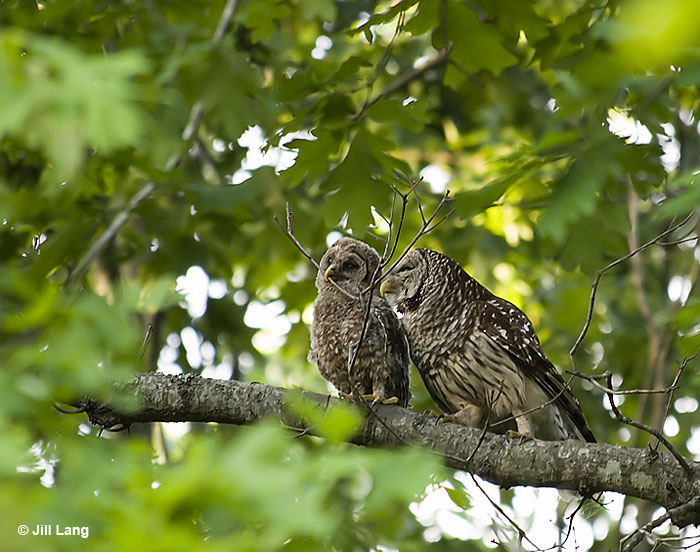The Barred Owl has the classic owl call commonly associated with treed swamps and old forests. These beautiful owls have brown-and-white-striped plumage and soulful brown eyes. They’re stocky, large owls with medium length, rounded tails, rounded heads, and no ear tufts.
They’re smaller than a Great Horned Owl and larger than a Barn Owl. They can pass by completely unnoticed due to their ability to fly silently. This bird was originally only found in the east, but during the 20th century, it spread through the Pacific Northwest and southward into California.
They live in mature, extensive forests that have both evergreens and deciduous trees near water.
Identification
Barred Owls are overall white and mottled brown. They have dark brown eyes that can sometimes look black. Their underparts are mainly white and are marked with vertical brown bars.
The upper breast has horizontal brown bars. The tail and wings are white and barred brown. Additionally, it’s not uncommon to see these birds in pairs throughout the year.
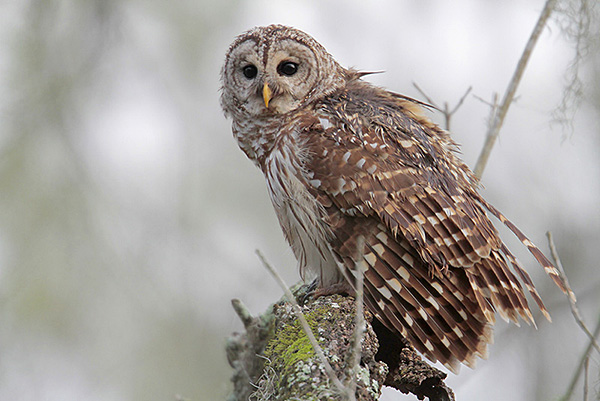
Photograph © Greg Lavaty.
Juvenile Barred Owls are fluffy and gray with a little bit of brown barring throughout. These birds tend to sit quietly while swiveling their head to listen for prey. These birds are generally nocturnal but can be seen in the evening and morning.
Food
The Barred Owl has a traditional owl diet. They eat many different small animals like chipmunks, squirrels, mice, rabbits, voles, birds as big as grouse, reptiles, invertebrates, and amphibians.
Barred Owls hunt by placing themselves on a high-up perch and waiting. This allows them to scan their surroundings with their incredible ears and eyes. Barred Owls sit on a perch by the water and wait for the perfect opportunity to catch a fish.
Additionally, they sometimes walk in shallow water to chase crayfish and fish. Barred Owls usually hunt at night or after sunset, but sometimes they come out and hunt during the day. For the time being, these owls may even place their prey in a curve of a branch, at the top of a snag, or in a nest.
They swallow large prey in segments and small prey whole. They’ll first eat the head and then the body next.
Nesting and Eggs
Barred Owls will use a naturally occurring cavity for their nest. These cavities are usually in large trees with a height of 20 to 40 feet.
They may also utilize platform stick nests that other animals built, like hawks, ravens, squirrels, and crows. Additionally, they might use nest boxes made by humans.
Barred Owls may scout nest sites early, it’s been recorded that Barred Owls will scout a year before. It’s not known which parent chooses the nesting site.
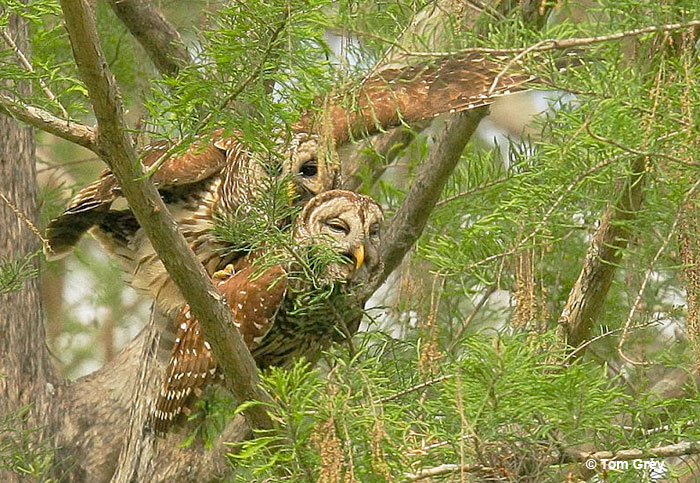
Barred Owls do nothing or very little to change a platform nest that’s been abandoned or an existing cavity. They may add fresh conifer sprigs, feathers, or lichen, and they may flatten or remove the top of an abandoned squirrel nest. Cavities can be 14 to 21 inches deep and 10 to 13 inches wide.
These measurements can vary greatly. Amazingly, one cavity that Barred Owls used was recorded to have a depth of 8 feet.
Barred Owls’ clutch size can range anywhere from one to five eggs. They usually have one brood during the breeding season and incubate the eggs for around 30 days. After that, the baby owls stay in the nest for around 35 days.
Current Situation
Barred Owls live in mixed forests of large trees near water year-round. These birds tend to occur in unfragmented, large blocks of mature forest. It’s theorized that old woodlands are more likely to have large cavities suitable for nesting and a larger diversity of prey.
They’ll live in a wide range of habitats, including streamsides, swamps, and uplands that contain maple, hemlock, oak, beech, hickory, aspen, quaking aspen, white spruce, balsam poplar, western larch, lodgepole pine, and Douglas-fir.
There is a decent amount of Barred Owls. The Barred Owl population increased by 1.1% every year between the late 1960s and 2019. Their breeding population is estimated at around 3.5 million.
Until the 20th century, Barred Owls were residents of undisturbed, old forests in the eastern portions of North America. They were most likely unable to move west due to frequent forest fires.
Tree planting and fire suppression in the Great Plains helped Barred Owls to move north and west during the past century. They eventually found their way to the West Coast, where they began encroaching on Spotted Owls. This was not great for their population. Additionally, Barred Owls have displaced these owls and have been hybridizing with them. This continues to threaten the Spotted Owl population.
According to the IUCN Red List, Barred Owls are a species of least concern.
Facts
- The Barred Owls mainly consist of small mammals, but they’ll sometimes go fishing for crabs, fish, and crayfish. Like Flamingos, if a Barred Owl consumes enough crayfish, the white feathers under their wings can turn pink!
- Barred Owls have 1 clutch of 2 or 3 eggs each breeding season and mate for life. During the incubation period, the female is the one the sit on the eggs while the male goes out and hunts for food.
- If you’re out in the woods and hear “who cooks for you, who cooks for you all?” you’re hearing the distinct call of a Barred Owl! If you hear something similar to maniacal laughter, that’s usually 2 Barred Owls conducting a courtship duet.
- The order in which chicks hatch usually determines their size. Therefore, the youngest of a Barred Owl clutch tends to be the smallest, with the other chicks progressively getting bigger the older they are.
- After hatching, juvenile Barred Owls hang around the nest for up to 6 months. This is not common for owls. During this time, the juvenile owls will hardly stray from each other and often sit next to each other.
Similar Species
The Barred Owl has features that are similar to other bird species. Here are some similar species:
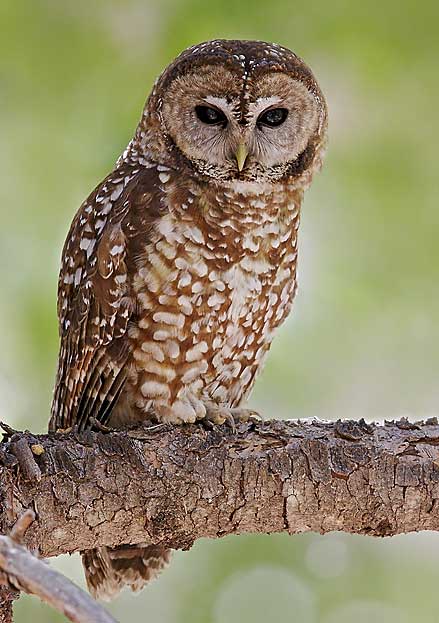
Spotted Owl. Photograph © Glenn Bartley.
Barred Owls have brown vertical barring while Spotted Owls have brown underparts that are patterned with white spots.
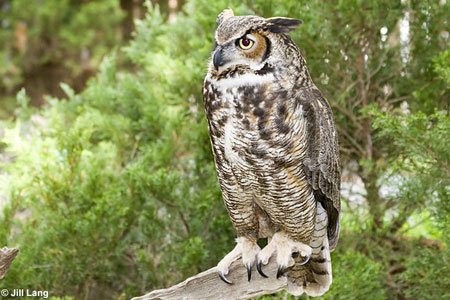
great-horned owl
Barred Owls have rounded heads with dark brown eyes.
Great Horned Owls have very obvious ear tufts and yellow eyes.
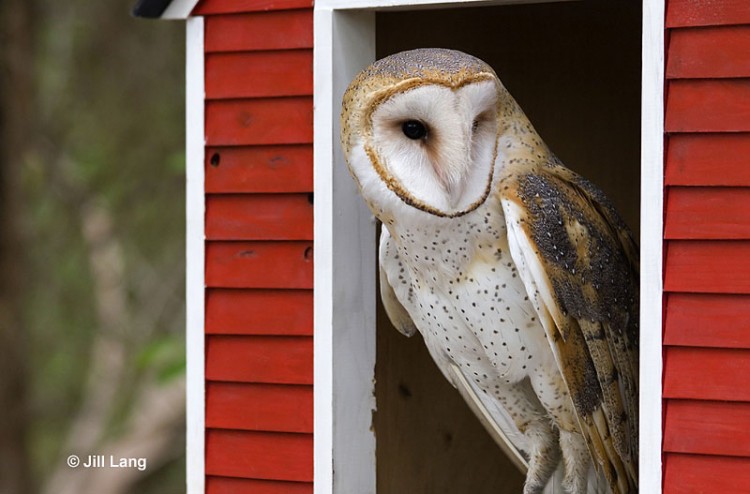
Barn Owl
Barred Owls are much darker than Barn Owls. They have lightly spotted or plain bellies, while Barred Owls have brown vertical barring.
Additionally, Barred Owls frequent forests, while Barn Owls frequent open country.
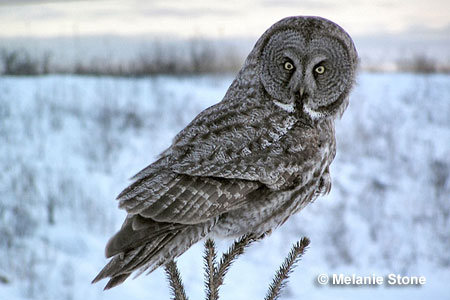
great gray owl
Barred Owls are not as gray as Great Gray Owls and are smaller overall.
Additionally, Barred Owls have dark brown eyes, while Great Gray Owl eyes are yellow.
Related: Owl identification
Frequently Asked Questions
Is it rare to see a Barred Owl?
No, it is not rare to see a Barred Owl. These birds are widespread and common.
What is special about the Barred Owl?
Most owls have yellow eyes, but not the Barred Owl! Barred Owls have brown eyes that can sometimes look black depending on the lighting. Additionally, they’re sometimes called laughing owls due to their unique vocalizations.
Why do Barred Owls laugh?
Barred Owls “laugh” when conducting a courtship duet.
Is a Barred Owl aggressive?
Yes, Barred Owls can be aggressive. They’re very territorial and can be aggressive towards intruders who encroach on their territory. This is especially true during nesting season. These owls have been known to chase intruders away while hooting loudly and will sometimes even strike with their feet.

